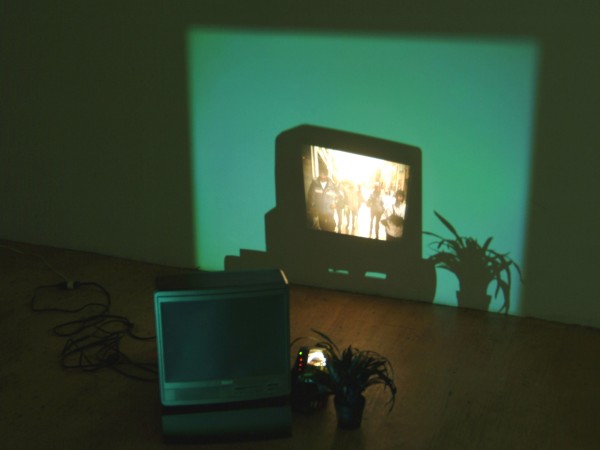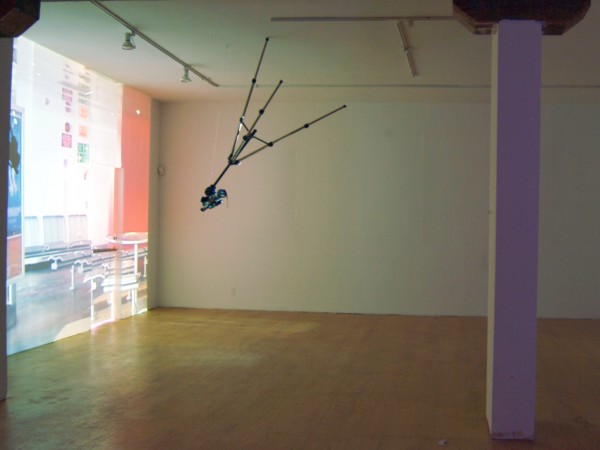Each artist residency is an appointment. For this Brazilian artist, this appointment was taking place in January and February 2006 in Quebec, a French-speaking city, not multi-ethnic, a favourable ground to feed its reflexions on the way he and people in general compose and perceive their natural, cultural and social environment.
The life of wonder he chose to carry out as an artist who lives in so many various cities made him sensitive to the impact of urbanization on landscapes. Threatened more and more by interests centered on the economy and universalization, the character and charm of the cities are being lost to the profit of a standardization.
Thus, what attracts him in all these cities where he stays is their singularity, their authenticity. The attentive glance that he gives on the objects and the human beings that he crosses results in an installation which gives us a chance to see exoticism in what seems familiar to us. That is so true that at the time of the installation’s presentation, many people questioned the source of the images: however, all of them came from his observations of Quebec and were not digitally reworked.
Having quickly understood that the whims of the winter are one of inherent realities in Quebec, a lot of Câmara’s pictures, captured outside, refer to it and show the good will of our walker to impregnate himself to this reality. Workers detaching the ice flows hung in the edge of roofs, architectural details of houses which have as a function to compose with snow, the sign indicating “Danger: fall of ice”, winter’s buoys on the river, mobile equipment of snow clearance, low walls and shelters of cars set up for a few months, trees tangled and sculptures of ices in front of commerce. But also, some large plans of faces with the cheeks reddened by the cold and the wind, of the wool mittens encrusted in the snow, of the traces of foot step after a storm, the bridge whose silhouette is guessed under the fog. There is also a whole selection of pictures reporting to various moments of Québec’s Winter Carnaval’s festivities. Visual and sound captations made of the processions, dances and traditional autochtone’s songs or resulting from the Quebecer’s folklore coming to insist as much on differences, than on the affinities of this carnival with Rio de Janeiro’s, one closer to its Brazilian roots.
Whether it is with photography or video, Frederico Câmara has an acute sense of the image and of sounds. During his artist residence of six weeks, he regularly improves the presentation of his installation by new images but always by maintaining the feeling of a purified where the sound presence also plays a part of importance. Plunged in a French-speaking environment in which he does not speak or understand the language, Frederico Câmara showed attention with the musical quality of the words instead of their meaning. This concern is present in the installation: in addition to the songs evoked previously, the snatches of conversation, the songs of birds and the urban noises form a dynamic sound screen. This superposition of various sounds and many images presented in the showroom transforms our way of perceiving and interiorizing them : because if certain sounds have a coherent bond with the image, others create more uncommon associations. In this chapter, the setting in of images referring to typical winter environments and other sounds of his visit in the luxiriants gardens of the indo-Australian greenhouse of the zoo comes to amplify the contrasting effects. The visual and sound device set up by Frederico Câmara is based on changes of rhythm, marking pauses of silence here for better setting out again there, while making it possible for the spectator to test continuous feelings, but without being sharp with it. Because its approach is more contemplative: it is a praise of slowness. Instead of causing the things, he leaves them time to appear. He photographs with understanding and generally films in fixed plan.
The result, in showroom, in addition this concept of slowness which encourages us to concentrate especially as the semi-darkness which reign intimist supports to the work. One will certainly remember this sequence where we see jellyfishes moving (the suns of the sea, so nicely called in Acadie) while hearing in filigree the surge of merry and crystalline voices of it children. The video of these languorous watery displacements enjoy a remarkable ambiguity: fuzzy and monochromic appearances they are however color and it is the darkness and the depth of water, frays to the evanescence of these marine animals which cause these intriguing effects. Exploiting several registers of scales and textures of the images (projection full wall or delimited by the format of the monitor TV or even sometimes directly of the numerical camera set on a tripod), the artist shares with us the subjects of predilection which he develops in this project: urban scenes and others coming from the park aquarium and the zoological garden. He is interested in the things available that these three topics procure to him and a whole series of questions in their connection is posed.
Although at the time of his visit in Quebec a strong controversy surrounding closing of the Zoological garden of Quebec largely occupied the media place, it is not what encouraged him to integrate it into the center of his reflexion. Some of his former artistic projects show that these places were conceived to safeguard the animal, vegetable and marine species, with all the load of exoticism which emerges from the zoo’s collections, aquariums, botanical gardens and other museums, are for him a source of inspiration. Denatured of their medium of origin, these various species are preserved in captivity under conditions where an artificial environment is recreated, a fragile ecosystem being able constantly to rock, following the example cities.
One of the filmic sequences dominating is the one of the bird in the indo-Australian greenhouse of the zoological garden which is filmed during a score of minutes in fixed plan. Lonely on its perch, it makes singing exercises, stopping only seldom its trilles to lean the head nervously, to question glance, to change position into hopping and shaking its wings. This sequence is retransmitted on a TV monitor, such a new luminous cage locking up this bird which one does not know if its song expresses the complaint or the joy, concern or the light call and enjolor. This go in private appointement with the bird (a stool is placed just opposite the monitor) is perhaps to confront the spectator with his own existential condition where it is able itself to feel more captive than free, only with people, exposed to the glances, trustful or hesitant, sad or happy.
It would not be the first time that Frederico approaches this set of themes as shows other artistic installation-performance entitled “Habitat” which was held in 2003. Taking as an inspiration the account of people who are praticing climbing and are seen often constrained to spend the night on the mountainside, the trunk of an oak, such a perch, was installed with five meters high off the ground in his workshop. During ten consecutive nights consecutive, under the glance of the visitors having access to the place at that time, he gave himself the challenge to sleep on this bed of fortune, under which a mountain of hay was set up, out of which everyday day a quantity was taken until there is no more, thus accentuating the extreme vulnerability of the artist in the event of fall.
His work generally underlines the precariousness of the condition of artist in particular, since nearly ten years lives as in various countries. Because if it needs already a good amount of courage to be an artist, it is necessary even more to be an artist living elsewhere than in his own country.
By carrying out artistic residences throughout the world it is each time a new training of the manhole which is essential on him by the discovery of new places, public and deprived, and of the people who move there. This life of wonder is the honey which nourishes his work elsewhere which, in their turn, takes us along far.
But the art of Frederico Câmara is not necessarily autobiographical, nor claiming, and even less moralizer. If one were to seek the greatest form of engagement of this work, it would be in that of a fight, subtle, but tough, with the wear of the sensory experiments, that of the crumbling of the glance which leads us surreptitiously, a day, more not to see or notice this and those which surround us.
I preserve in me the happy memories of my visits of the exposure of this artist, each time discovering a new version, thorough concerns holding to him with heart. That encourages me to put this quotation of Maria Rilke in conclusion.
“I learn to see. I do not know to what that holds to, but all penetrates more deeply in me and does not stay at the place where, usually, that always came to be completed. I have an inside of which I did not know anything. Everything is going there (…) I ,for example, had never become aware of the great number of faces which exist. There is a crowd of people, but way more faces still, because every individual has several of them.>”1
- Rilke, Rainer Maria. 1995,″ Les carnets de Malte Laurids Brigge ″. New translation of Claude Porcell, Flammarion editions, Paris, p. 25.


